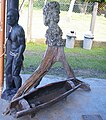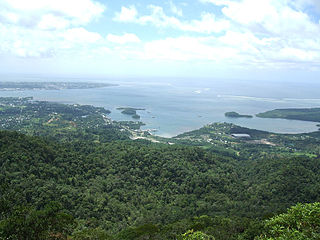
Suva is the capital and largest city of Fiji. It is the home of the country largest metropolitan area and serves as its major port. Located on the southeast coast of the island of Viti Levu, in Rewa Province, Central Division.
Fiji is an island nation in the Pacific Ocean. Though geographically Melanesian, the music of Fiji is more Polynesian in character. Nevertheless, Fijian folk styles are distinct in their fusion of Polynesian and Melanesian traditions. Folk music is dominated by vocal church music, as well as dances characterized by rich and dull harmony and complex percussion made from slit drums or natural materials, such as drums.

Music of Samoa is a complex mix of cultures and traditions, with pre- and post-European contact histories. Since American colonization, popular traditions such as rap and hip hop have been integrated into Samoan music.

A slit drum or slit gong is a hollow percussion instrument. In spite of the name, it is not a true drum but an idiophone, usually carved or constructed from bamboo or wood into a box with one or more slits in the top. Most slit drums have one slit, though two and three slits occur. If the resultant tongues are different width or thicknesses, the drum will produce two different pitches. It is used throughout Africa, Southeast Asia, and Oceania. In Africa such drums, strategically situated for optimal acoustic transmission, have been used for long-distance communication.

Calophyllum inophyllum is a large evergreen plant, commonly called tamanu, oil-nut, mastwood, beach calophyllum or beautyleaf. It is native to tropical Asia and Wallacea. Due to its importance as a source of timber for the traditional shipbuilding of large outrigger ships, it has been spread in prehistoric times by the migrations of the Austronesian peoples to the islands of Oceania and Madagascar, along with other members of the genus Calophyllum. It has since been naturalized in regions in the East African coast. It is also a source of the culturally important tamanu oil.
The culture of Fiji is a tapestry of native Fijian, Indian, European, Chinese, and other nationalities. Culture polity traditions, language, food costume, belief system, architecture, arts, craft, music, dance, and sports will be discussed in this article to give you an indication of Fiji's indigenous community but also the various communities which make up Fiji as a modern culture and living. The indigenous culture is an active and living part of everyday life for the majority of the population.
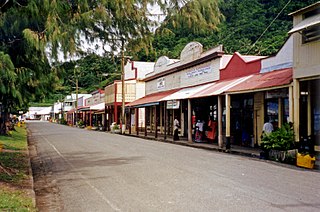
Levuka is a town on the eastern coast of the Fijian island of Ovalau, in Lomaiviti Province, in the Eastern Division of Fiji. Prior to 1877, it was the capital of Fiji. At the census in 2007, the last to date, Levuka town had a population of 1,131, about half of Ovalau's 8,360 inhabitants. It is the economic hub and the largest of 24 settlements on the island. Having been nominated decades prior, Levuka was designated a UNESCO World Heritage Site in June 2013, in recognition of the port town's exceptional testimony to the late colonial port towns in the Pacific.
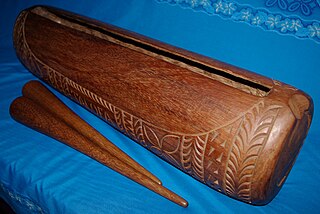
The Pātē is a Samoan percussion instrument of Tahitian origin, named after the Samoan word for "beat" or "clap" "pulse". It is one of many Samoan log drum variants and is of the slit drum family, and therefore is also of the idiophone percussion family. It is made from a hollowed-out log, usually of Miro wood and produces a distinctive and loud sound. Different sizes of log drums offer different pitches and volumes, as well as striking the log drum in the middle or near the ends.

Nadroga-Navosa is one of the fourteen provinces of Fiji and one of eight based in Viti Levu, Fiji's largest island. It is about 2,385 square kilometers and occupies the South-West and Central areas of Viti Levu, Fiji's principal island. The province includes the Mamanuca Archipelago, off the west coast of Viti Levu, Vatulele, as well as the remote Conway Reef in the southwest. The population at the 2017 census was 58,931, being the fifth largest province. The main town in Nadroga-Navosa is Sigatoka, with a population of 9622.
Dr John Charles Fatiaki is a career medical practitioner who was chosen by the Rotuma Island Council to be their representative in the Fijian Senate.
Taukei ni Waluvu is a Fijian phrase for "Native of the Flood." It is the traditional chiefly title of the warrior hill clan Siko-Natabutale of Nairukuruku village. The history of the clan from the mid- nineteenth century, represent the social structures of the chiefly system, religion and western culture that supported colonialism in Fiji. Tradition, Christianity and British indirect rule were combined to legitimize what was accepted as the right way to govern. Condemned by some modern day critics as exploitative, the Fijian chiefly system was the medium of native social interdependence and a traditional contract shared by the indigenous clans of pre-colonial Fiji, that was utilized for colonial rule. Since Independence the chiefly system has had to adapt to the demands of modernity. Anthropologist Arthur Capell in his study of early tribal migration within Fiji made the point that, "the history of Fiji is the history of chiefly families." The phrase in fact emphasized the hierarchical nature of Fijian traditional society where chiefly power was held sacred. The relationship between Chiefs and Westerners in especially Missionaries thus became a focal point for gathering insight into Fijian culture and tradition in the nineteenth century. James Turner a latter anthropologist found, "The chiefly families of Nairukuruku were the first in the eastern highlands of Viti Levu to declare their allegiance to the central government and as a result of this support their influence expanded throughout the area".

Camakau are a traditional watercraft of Fiji. Part of the broader Austronesian tradition, they are similar to catamarans, outrigger canoes, or smaller versions of the drua, but are larger than a takia. These vessels were built primarily for the purposes of travelling between islands and for trade. These canoes are single hulled, with an outrigger and a cama, a float, with both ends of the hull being symmetrical. They were very large, capable of travelling open ocean, and have been recorded as being up to 70 ft in length.

Francis Herbert Dufty II (1846–1910), who was also known as Frank Dufty, was an English-born, Australian photographer, known for his photographs of Fiji. Dufty's contribution to Fiji was of primary importance in the 1870s, and he was one of Fiji's most significant, early photographers.

The i-sala is a traditional Fijian headdress, similar in shape to a headscarf or turban, and part of the traditional attire of the chiefly and priestly classes of the islands of Fiji as a sign of rank. Other variant of the name include sala, i-zinu, i-uso or i-uho, vauvau or paupau and masi turban. I-sala or ai Sala literally means "wrapper or envelope" in the Fijian language.
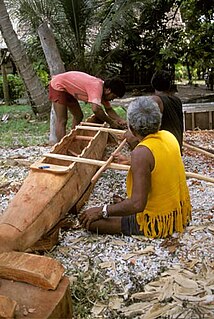
A paopao, is the name used by the Polynesian-speaking inhabitants of the Ellice Islands for their single-outrigger canoes, of which the largest could carry four to six adults. The large double-hulled sailing canoes had ceased to be constructed in the Ellice Islands some time before contact with Europeans.
The architecture of Fiji has its own unique style and pattern. While Fiji is a famous travelling destination among tourists for its beaches and beauty, its architecture is unique and particularly attractive. Fiji is a pacific island belonging to the scope of tropical marine climate, whose capital and the country's largest city is Suva. As a coastal city, the main architectural style of the urban centre, Suva has a foreign classical beauty, antique as if back to a few centuries ago. It often reflects the socio-cultural heritage of the locale and the country. However, with the development in the society of Fiji and the spread of globalization, the architectural scenario has incorporated several foreign styles without affecting the original style and yet enhancing the aesthetic value. The richness of Fiji's architecture can be comprehended from diverse styles of architectural designs for different kinds of buildings. Moreover, the architecture of the country changes with region to region and has varied influences. Additionally, it is notable that the architecture of this country can provide insights to the architects around the world regarding the aesthetically appealing patterns and scientifically viable designs which would enhance the significance of the built environments.
The Ula or I Ula Tavatava is a throwing war club from Fiji.
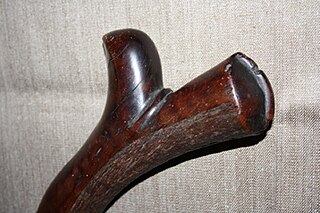
The Gata or Gata waka is a war club from Fiji.

A Sali or Cali or Tebetebe is a war club from Fiji.

A Culacula is a paddle war club from Fiji.


